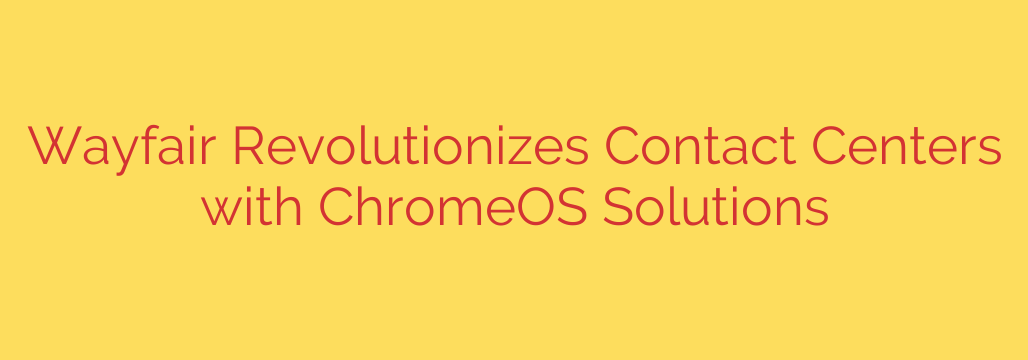
Rethinking the Modern Contact Center: How a Cloud-First OS Boosts Security and Efficiency
The landscape of customer service has fundamentally changed. The era of massive, centralized call centers is giving way to a more flexible, distributed model, with thousands of agents working from home. This shift presents enormous opportunities for scalability and talent acquisition, but it also creates significant logistical and security challenges. How do you efficiently manage, secure, and support thousands of devices for a remote workforce?
For many growing enterprises, the answer lies in moving away from traditional operating systems and embracing a cloud-native approach. By adopting a secure, centrally managed, and easy-to-deploy operating system, companies are revolutionizing their contact center operations, slashing costs, and strengthening their security posture simultaneously.
The Challenge: Managing a Distributed Workforce at Scale
As companies expand their customer service teams, especially with remote agents, IT departments face a complex set of problems. Provisioning new hardware, installing software, troubleshooting issues, and ensuring every agent has secure access to sensitive customer data becomes a logistical nightmare.
Traditional methods, which involve manually imaging laptops or shipping devices back and forth for maintenance, are slow, expensive, and don’t scale effectively. Furthermore, relying on agents’ personal devices introduces unacceptable security risks. This operational friction can lead to delayed onboarding, frustrated agents, and a weakened defense against cyber threats.
The Solution: A Strategic Shift to Cloud-Based Operations
A cloud-first operating system offers a powerful solution to these challenges. By design, these systems are built for a world where applications and data live in the cloud, making them inherently more secure, lightweight, and easier to manage remotely.
This approach allows IT teams to treat hardware as a simple, interchangeable gateway to a pre-configured, secure environment. For contact centers, this translates into a number of game-changing benefits.
Key Benefit 1: Fortified Security for Remote Teams
When agents handle customer information from remote locations, security is paramount. A cloud-based OS provides multiple layers of defense that are critical for protecting sensitive data.
- Built-in Protection: These systems feature automatic security updates, sandboxing (which isolates apps from the core system), and verified boot processes that check for tampering every time a device starts up.
- Centralized Control: IT administrators can enforce security policies across the entire fleet of devices from a single web-based console. This includes disabling USB ports, restricting app installations, and enforcing strong login credentials.
- Rapid Offboarding: If an agent leaves the company, their access can be revoked instantly, and the device can be remotely wiped, ensuring no company data is left behind. This is a critical advantage for managing a fluid workforce.
Key Benefit 2: Effortless Scalability and IT Management
Perhaps the most significant operational win is the simplification of device deployment and management. With a system built around cloud profiles, the heavy lifting is removed from the IT department.
The modern standard is zero-touch enrollment, a process that transforms onboarding. A new device can be shipped directly from the manufacturer to an agent’s home. The agent simply unboxes it, connects to the internet, and logs in with their company credentials. The device automatically configures itself with all the necessary applications, settings, and security policies in minutes—not hours or days.
This streamlined process drastically reduces IT support tickets and frees up technical staff to focus on more strategic initiatives instead of repetitive setup tasks.
Key Benefit 3: Empowering Agents for Better Performance
Agent experience is directly linked to customer satisfaction. A slow, clunky, and unreliable computer is a constant source of frustration and lost productivity. Cloud-native devices are known for their fast boot times, simple interface, and long-lasting battery life.
By providing agents with technology that just works, companies can reduce friction and empower their teams to focus on what they do best: helping customers. A streamlined and reliable workflow directly impacts agent satisfaction and retention, which is a crucial metric in the high-turnover contact center industry.
Actionable Steps to Modernize Your Contact Center
Is your organization ready to improve security and efficiency? Here are a few steps to consider when exploring a cloud-based OS for your contact center operations:
- Assess Your Current Infrastructure: Identify the biggest pain points in your current device management and security protocols. Where are you spending the most time and money?
- Define Your Security Needs: Determine the specific policies required to protect your customer data, such as access controls, data loss prevention, and remote management capabilities.
- Run a Pilot Program: Start with a small group of agents to test the new system. Deploy devices using zero-touch enrollment and gather feedback on performance, usability, and the management experience.
- Measure the Impact: Track key metrics before and after the pilot, including device setup time, the number of IT support tickets, and agent feedback. Use this data to build a business case for a full-scale rollout.
Ultimately, migrating a contact center to a cloud-based operating system is more than just an IT upgrade—it’s a strategic business decision that delivers enhanced security, massive operational efficiency, and a better experience for agents and customers alike.
Source: https://cloud.google.com/blog/products/chrome-enterprise/wayfair-transforms-contact-center-operations-with-chromeos-and-chromeos-flex/








